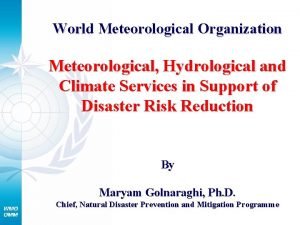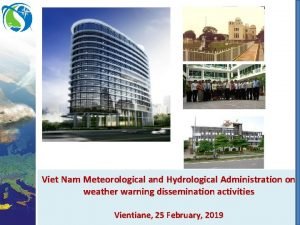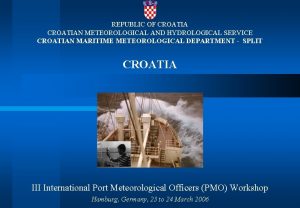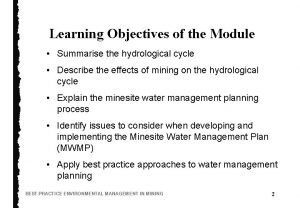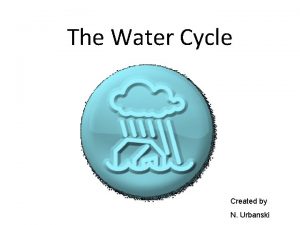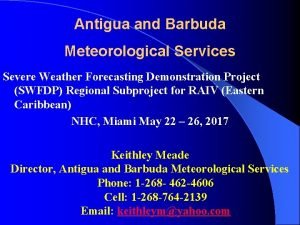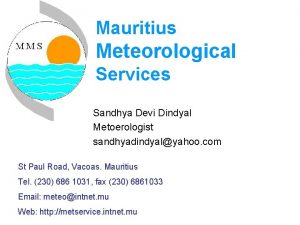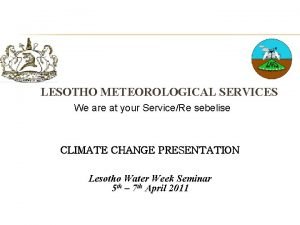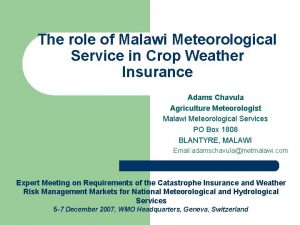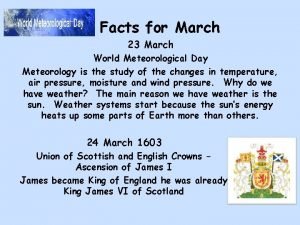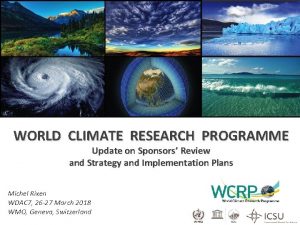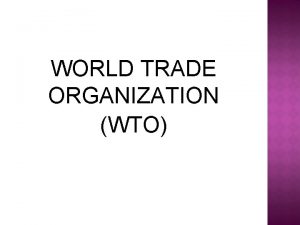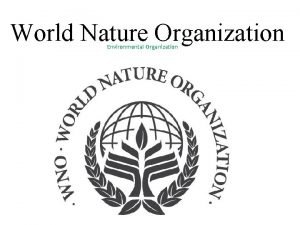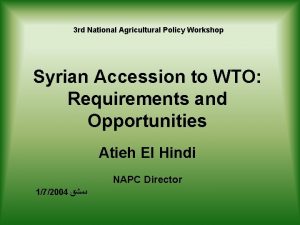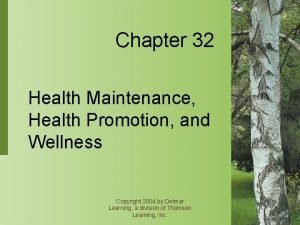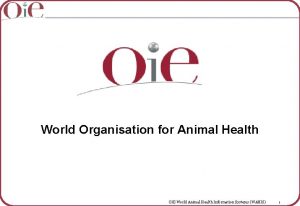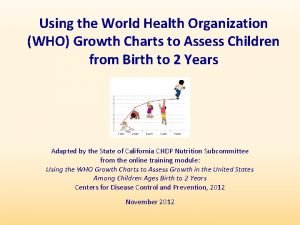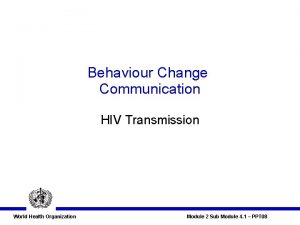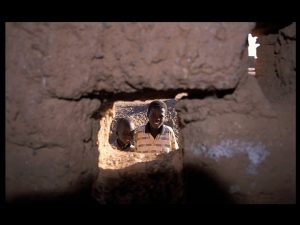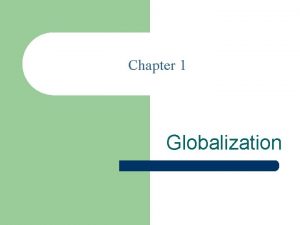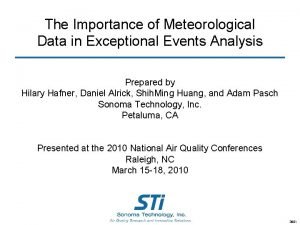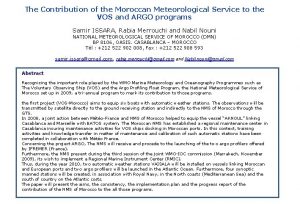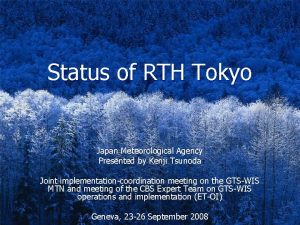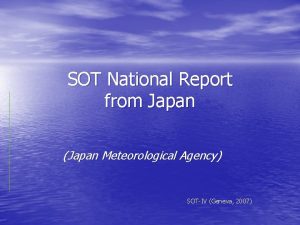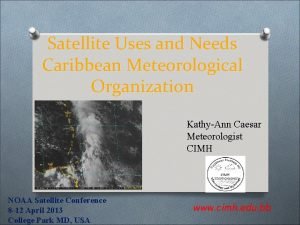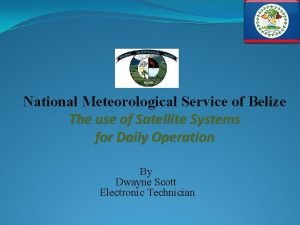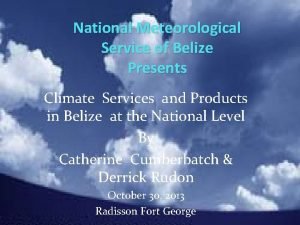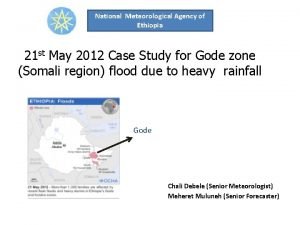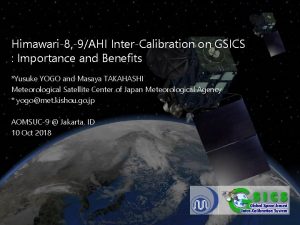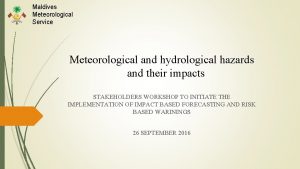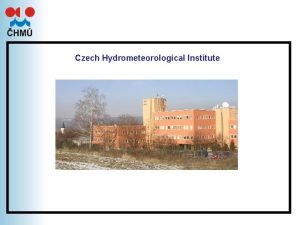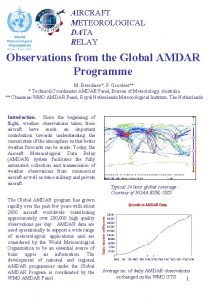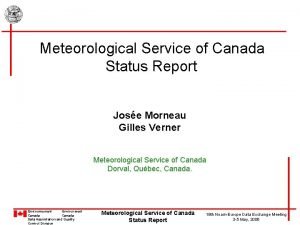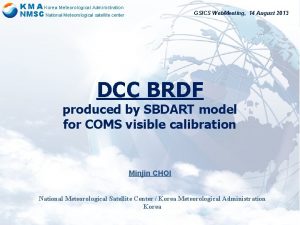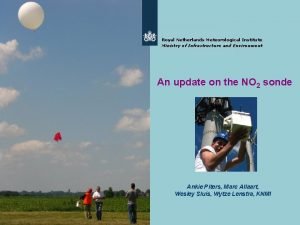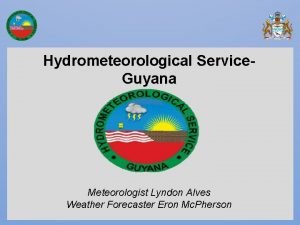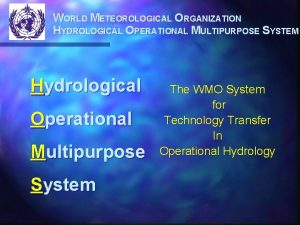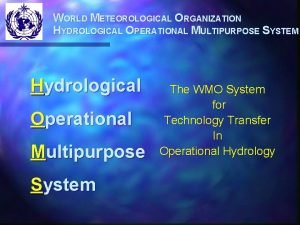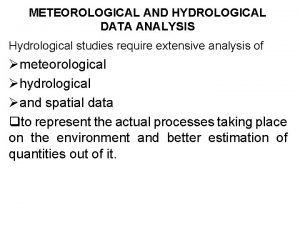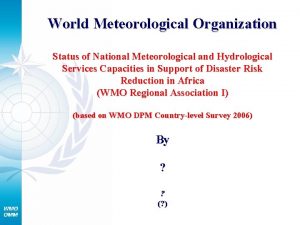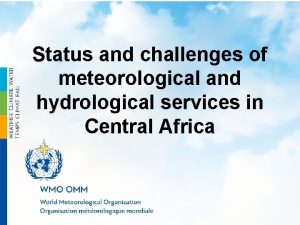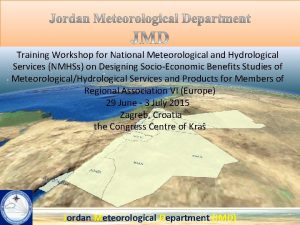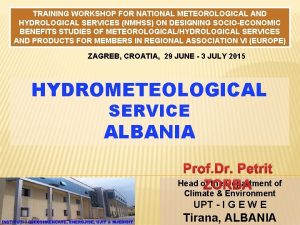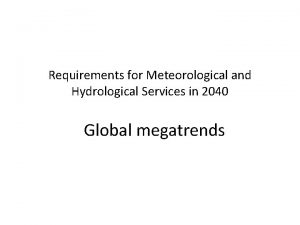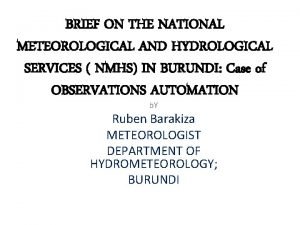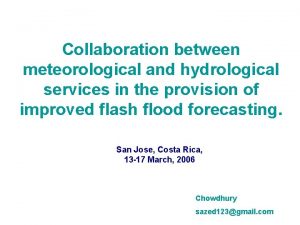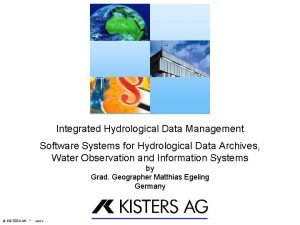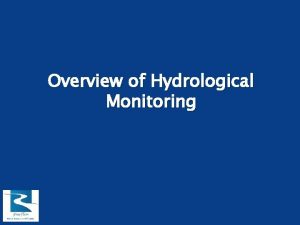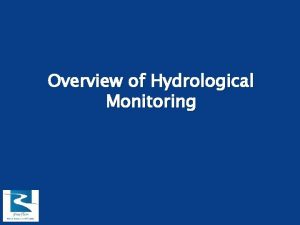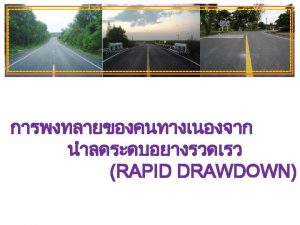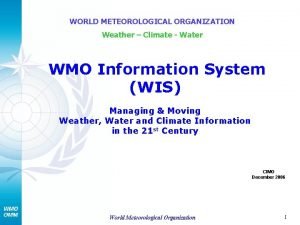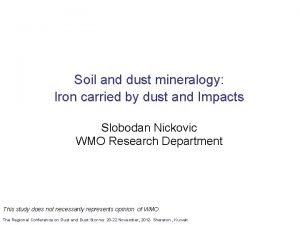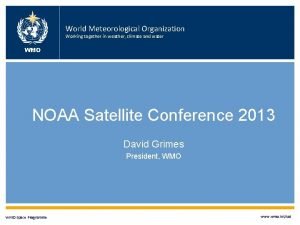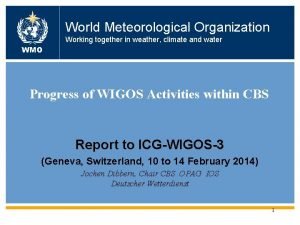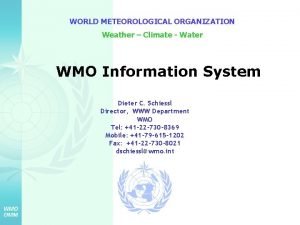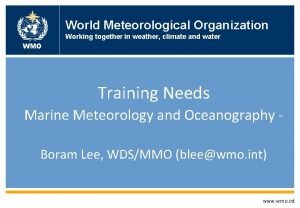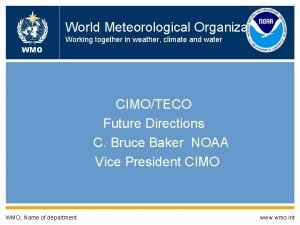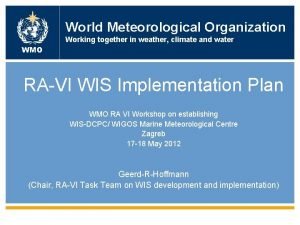World Meteorological Organization Meteorological Hydrological and Climate Services





















































- Slides: 53

World Meteorological Organization Meteorological, Hydrological and Climate Services in Support of Disaster Risk Reduction By Maryam Golnaraghi, Ph. D. Chief, Natural Disaster Prevention and Mitigation Programme

We cannot avoid hazards

…but we can Prevent Them from Becoming Disasters Source: World Resources Institute

Agenda 1. Impacts of Weather-, Water- and Climate-Related Extreme Events 2. Reducing / Managing Risks of Disasters 3. Benefits of Meteorological, Hydrological and Climate Services to Disaster Risk Reduction 4. Assessing Capacities, Requirements and Priorities at National and Regional Levels 5. WMO Disaster Risk Reduction Programme Action Plan

Impacts of Weather-, Water- and Climate. Related Extreme Events

Number of Disasters (1980 -2005) Nearly 90% of disasters are related to hydro-meteorological hazards. Source: EMDAT: The OFDA/CRED International Disaster Database - www. em-dat. net - Université Catholique de Louvain - Brussels - Belgiumc

Loss of Human Life (1980 -2005) Nearly 70% of loss of life are related to hydro-meteorological hazards. Source: EM-DAT: The OFDA/CRED International Disaster Database - www. emdat. net - Université Catholique de Louvain Brussels - Belgium

Economic Losses (1980 -2005) Nearly 75% of economic losses are related to hydro-meteorological hazards. Source: EM-DAT: The OFDA/CRED International Disaster Database - www. emdat. net - Université Catholique de Louvain Brussels - Belgium

90% of Disasters are Hydro-Meteorological (Number of Events, 1980 -2005) Source: EM-DAT: The OFDA/CRED International Disaster Database - www. em-dat. net - Université Catholique de Louvain - Brussels - Belgium

Regional Distribution of Natural Disasters (Loss of life, 1980 -2005) Earthquake: 30 000 Heatwave: 50 000 Windstorms: 230 000 Flooding: 40 000 Windstorms: 30 000 Earthquake: 205 000 Tsunami: 60 000 Epidemics/famine: 260 000 Windstorms: 40 000 Landslides: 15 000 Flooding: 45 000 Drought: 500 000 Earthquake: 155 000 Epidemics/famine: 120 000 Tsunami: 170 000 Source: EM-DAT: The OFDA/CRED International Disaster Database - www. em-dat. net - Université Catholique de Louvain - Brussels - Belgium

Regional Distribution of Natural Disasters (Economic Losses in billion USD, 1980 -2005) Flooding: 69 Earthquake: 50 Windstorms: 39 Flooding: 194 Flooding: 8 Windstorms: 30 Windstorms: 90 Earthquake: 10 Drought: 3 Earthquake: 170 Earthquake: 11 Wild Fires: 18 Flooding: 23 Drought: 5 Flooding: 3 Windstorms: 3 Earthquake: 9 Drought: 11 Tsunami: 4 Windstorms: 14 Source: EM-DAT: The OFDA/CRED International Disaster Database - www. em-dat. net - Université Catholique de Louvain - Brussels - Belgium

Conclusions from IPCC WG II (Impacts, Adaptation and Vulnerability) Phenomenon Likelihood Major projected impacts Increased frequency of heat waves Increased frequency of heavy precipitation events Very likely Area affected by drought increases Intense tropical cyclone activity increases Likely Increased incidence of extreme high sea level Likely Increased risk of heat-related mortality Increased loss of life and property due to flooding, and infectious, respiratory and skin diseases Increased risk of food and water shortage Increased risk of deaths, injuries, water- and foodborne diseases; Disruption by flood and high winds; Potential for population migrations, loss of property Increased risk of deaths and injuries by drowning in floods; Potential for movement of populations and infrastructure Very likely Likely

Climate Change and Disaster Management

WMO Scientific and international research Programmes - Advancing the knowledge of natural hazards and their changing patterns Northern Atlantic Oscillation La Niña Pacific Decadal Oscillation

Economic Losses are on the Way Up Source: EM-DAT: The OFDA/CRED International Disaster Database - www. emdat. net - Université Catholique de Louvain - Brussels - Belgium

While Casualties related to Hydro. Meteorological Disasters are Decreasing Source: EM-DAT: The OFDA/CRED International Disaster Database - www. emdat. net - Université Catholique de Louvain - Brussels - Belgium

Weather-, Water- and Climate-Related Disasters Impact across many Sectors, Setting Back Socio-Economic Development by Years if not Decades Energy Water Resource Management Food security Transport Health Industry

Reducing / Managing Risks of Disasters

What do we Mean by Risk ? Hazard Risk Intensity Vulnerability HIGHER RISK Vulnerability Frequency

Disaster Risk Management Involves a Wide Range of Decisions and Actions Disaster Risk Management Risk Identification ® Historical hazard data and analysis Changing hazard trends Vulnerability assessment Risk quantification Risk Reduction Sectoral planning Early Warning Systems Emergency Preparedness planning Education and training Risk Transfer Financial tools • Insurance • Weather derivatives • Cat bonds

Need for Partnerships and Coordination Among Different Players

Need for Effective and Harmonized Governance, Organizational and Operational Mechanisms

Shifting Disaster Risk Management from Reaction to Prevention • Traditionally, disaster risk management approach has been focused on emergency response and recovery measures World Conference on Disaster Reduction (WCDR) 168 countries adopted Hyogo Framework for Action (HFA) Kobe, Japan, January 2005 • Shifting disaster risk management to a more comprehensive approach, involving – – prevention preparedness contingency planning emergency response and recovery measures.

Benefits of Meteorological, Hydrological and Climate Services to Disaster Risk Reduction

National Meteorological and Hydrological Services Provide products and services, 24/7 Ø Meteorological, hydrological, climate and hazard information and mapping Ø Early Detection, Forecasts and Warnings (next hour to climate time scales) Severe storms, tropical cyclones (hurricanes and typhoons), storm surges, floods, cold spells, heat waves, droughts, forest fires, locust swarms, etc…

Return on Investment in Meteorological, Hydrological and Climate Services : 10 to 1 WMO Secretary-General, Madrid, 19 March 2007 Building capacities of National Meteorological and Hydrological Services is an investment toward national development.

WMO Scientific and international research Programmes - Advancing the knowledge of natural hazards and their changing patterns Northern Atlantic Oscillation La Niña Pacific Decadal Oscillation

WMO Coordinated Networks in Support of Disaster Risk Reduction: Observation & Communication Coordinated Satellite Activities Global Observing System Global Telecommunication System

Regional Coordinated Networks in Support of Early Warnings, Specialized Services and Training

Example of Regional Cooperation: WMO Global Tropical Cyclone Early Warning System Regional cooperation (6 Regional Centres) in support of national tropical cyclone early warning systems

Supporting National Capacities for Disaster Risk Management 24 hours a day, everyday of the year, in every country National Meteorological and Hydrological Services Products and Services Needs, requirements, Feedback

Contributions of National Meteorological and Hydrological Services to Risk Identification • Availability of historical and real-time hazard databases • Hazard analysis and mapping methodologies – – Severity , Frequency, Location, Timing Statistical analysis of historical data GIS/GPS mapping Probabilitic climate models – Forward looking trend analysis • Emerging technologies (factors in changing patters due to climate variablity and change)

Contribution of National Meteorological and Hydrological Services to Risk Reduction • Input into sectoral planning (zoning, development, etc) • Early warning systems – Probabilistic forecasting and warnings from next hour to longer climate timescales – Integration of risk information into warning messages – Communication and dissemination – Partnerships, joint planning and joint training with national agencies responsible of emergency preparedness and response • Meteorological Services in support of pre- and post -disaster response and relief operations

Contribution of National Meteorological and Hydrological Services to Risk Transfer products Insurance provider Government Weather derivatives Private sector Catastrophe bonds example – Crop / flood insurance – Agricultural and drought derivatives – Insurance for property and casualty – Micro-insurance – Weather derivatives – Catastrophe bonds for hurricanes

Assessing Capacities, Requirements and Priorities at National and Regional Levels

Systematic Assessment of Capacities, Requirements and Priorities By country groupings: 1. Hazards affecting the countries 2. Role of National Meteorological Services for disaster risk reduction 3. Capacities to deliver products and services in support of disaster risk reduction 4. Challenges, requirements and opportunities Global Survey of Scientific and Technical Capacities in Support of Disaster Risk Reduction At regional level: 1. Regional strategy for disaster risk reduction 2. Opportunities for partnerships

Responses to the WMO Country-Level DPM Survey 44/48 92 % 18/22 82 % 25/34 74 % 10/12 83 % 14/19 74 % 24/52 54 % 139 out of 187 Members (74 %) responded Least developed countries: 25/50 50 % Developing countries: 85/137 54 %

Major Hazards Affecting the Countries from the Country-Level Survey

Common Challenges for Disaster Risk Reduction Governance: – Demonstrating socio-economic benefits of prevention measures Organizational coordination: – Partnerships, definition of roles and responsibilities of every stakeholders Technical: – Telecommunications, internet access, computer hardware and software – Observing networks development and sustainability – Hazard data: data management, methodologies for data rescue, quality assurance, statistical analysis of hazard characteristics and mapping – Specialised forecasting services in support of risk reduction Education and Training: – Technical training and capacity development – Joint multi-disciplinary training with multiple agencies – Public outreach programmes Capacities are highly variable from country to country

WMO Disaster Risk Reduction Programme Action Plan

WMO Mechanisms to Support Members' Scientific and Technical Capacities Thematic 8 Technical Commissions Basic Systems (CBS) Instruments and Methods of Observations (CIMO) Hydrology (CHy) Atmospheric Sciences (CAS) Aeronautical Meteorology (CAe. M) Applications of Meteorology (AMP) Technical Cooperation (TCO) Atmospheric Research and Environment (AREP) World Climate (WCP) Regional (RP) 6 Regional Associations (RA) Oceanography and Marine Meteorology (JCOMM) 10 Programmes Hydrology and Water Resources (HWR) 2 World Meteorological Centres (WMC) Agricultural Meteorology (CAg. M) Climatology (CCl) Education and Training (ETR) Regional Space (WSP) Disaster Prevention and Mitigation (DPM) Members' National Meteorological and Hydrological Services (NMHSs) 40 Regional Specialised Meteorological Centres (RSMC) 30 Regional Meteorological Training Centres (RMTC) World Weather Watch (WWW) PARTNERS

WMO DRR Programme Vision: Enhanced contributions of National Meteorological and Hydrological Services Ø For protection of lives, livelihoods and property Ø Through strengthening of National Meteorological and Hydrological Services technical capacities and cooperation in disaster risk reduction Ø At national to international levels

Strategic Foundation Hyogo Framework for Action 2005 -2015 (World Conference on Disaster Reduction, Jan 2005) WMO Strategic Plan 2008 -2011 (Top Level Objectives and Five Strategic Thrusts) Strategic Goals of WMO in Disaster Risk Reduction

WMO Strategic Goals for DRR 1. Strengthening and sustainability of early warning systems 2. Analyzing and providing hazard information for risk assessment 3. Delivery of timely and understandable warnings and specialized forecasts -- driven by user requirements 4. Integration of NMHSs' products and services in disaster risk reduction, 5. Strengthening WMO/NMHS cooperation and partnerships at national to international level with disaster risk reduction organizations 6. Public outreach campaigns

Linking DRR Strategic Goals to Action Implementation through regional and national projects, with following end results: 1. Modernized NMHSs systems. 2. Strengthened national operational multi-hazard early warning systems. 3. Strengthened hazard analysis and risk assessment capacities. 4. Strengthened cooperation of NMHSs with civil protection and disaster risk management agencies. 5. Trained NMHS 6. Sustained capacities over time 7. Enhanced awareness ministerial and public

Examples of DRR Crosscutting Projects initiated in 2007 Project Country / Region Multi-Hazard Early Warning France and Shanghai Mega-City Severe Weather Forecasting South East Africa Global Flash Flood Guidance System Central America, followed by Africa Flood Risk Assessment To be initiated in 6 countries Drought Monitoring and Risk Assessment South East Europe & Africa Public Education and Outreach Global Other projects are also being considered for 2008 -2011

Multi-Hazard Early Warning Systems: Deliverables (1/2) (c) New Technical Guidelines D A T A Warnings, specialised forecasts, bulletins and other services (a) Governance, Organizational Coordination and Operational Processes Disaster Preparedness and Response Systems and Crisis Management (b) Cost-Benefits Analysis Protection of lives, livelihood Media and Internet SMS property Other

Multi-Hazard Early Warning Systems: Classification of Warnings to be Addressed (2/2) Early Detection, Monitoring and Warning Services Develop hazard monitoring and early warning services Type III Hazard fully under the mandate of NMHS Hazard under joint mandate of NMHS and other agencies Hazard under mandate of other agencies but NMHS contribute e. g. strong winds, strong rainfall, snow/ice, hail, tropical cyclone e. g. floods, air pollution, etc. e. g. locust, heathealth and other epidemics, volcanic ash transport, manmade hazards Level of coordination between NMHS and other agencies

Severe Weather Forecasting Initiated in 2006 in Madagascar, Mozambique, South Africa, Tanzania and Zimbabwe Tropical cyclone, heavy rainfall, strong wind In 2008, will expand to other countries in the region and involve the national civil security services

Global Flash Flood Warning Systems To develop flash flood warning capabilities, in priority in developing Countries with little resources. Countries: 20 -25 countries in Central America (2007), South East Asia (2007), Southern Africa (early 2008), Central Asia - Middle East (later part of 2008)

Flood and Drought Risk Assessment: Partnership with the Global Risk Identification Programme (GRIP) • Improve capacities for risk assessment methodologies and their utilisation in decision making. • Supports data archiving, analysis and use. DROUGHT FLOOD

Public Outreach Programmes: Roles of National Meteorological Services in Supporting Different Aspects of DRR • Joint publications and curricula involving experts from scientific and education background • Targeted at all aspects of disaster risk management, with particular focus on governance, institutional and operational capacities

Thank You For more information please contact: Maryam Golnaraghi, Ph. D. Chief of Natural Disaster Prevention and Mitigation Programme World Meteorological Organization Tel. 41. 22. 730. 8006 Fax. 41. 22. 730. 8023 Email. MGolnaraghi@WMO. int http: //www. wmo. int/disasters
 National meteorological and hydrological services
National meteorological and hydrological services Vietnam meteorological and hydrological administration
Vietnam meteorological and hydrological administration Croatian meteorological and hydrological service
Croatian meteorological and hydrological service Hydrological
Hydrological Water cycle heat transfer
Water cycle heat transfer Hydrological cycle diagram
Hydrological cycle diagram Hydrological prediction center
Hydrological prediction center Antigua met office
Antigua met office Climate change 2014 mitigation of climate change
Climate change 2014 mitigation of climate change Mauritius meteorological service
Mauritius meteorological service Lesotho meteorological services
Lesotho meteorological services Malawi meteorological services
Malawi meteorological services March 23 world meteorological day
March 23 world meteorological day How does wind affect weather and climate
How does wind affect weather and climate Difference between block and point-by point organization
Difference between block and point-by point organization Globalization ap world history definition
Globalization ap world history definition World climate programme
World climate programme Process organization in computer organization
Process organization in computer organization Function of world trade organization
Function of world trade organization Word nature organization
Word nature organization Largest sports organization in the world
Largest sports organization in the world Functions of the world trade organization
Functions of the world trade organization Health promotion and maintenance
Health promotion and maintenance Oie world organization for animal health
Oie world organization for animal health World health organization growth charts
World health organization growth charts World health organization
World health organization World health organization
World health organization World trade organization
World trade organization World trade organization
World trade organization Ap world history chapter 25 africa and the atlantic world
Ap world history chapter 25 africa and the atlantic world The changing world output and world trade picture
The changing world output and world trade picture The changing world output and world trade picture
The changing world output and world trade picture Integrated services vs differentiated services
Integrated services vs differentiated services Wake county human services community services center
Wake county human services community services center What letters designate an air mass from the gulf of mexico?
What letters designate an air mass from the gulf of mexico? Importance of meteorological data
Importance of meteorological data Morocco meteorological service
Morocco meteorological service Tokyo meteorological agency
Tokyo meteorological agency Bbxx ship
Bbxx ship Ramsdis
Ramsdis Meteorological service of belize
Meteorological service of belize National meteorological service belize
National meteorological service belize Ethiopian meteorological agency
Ethiopian meteorological agency Meteorological satellite center of jma
Meteorological satellite center of jma Tornado in maldives
Tornado in maldives Colored area
Colored area Czech hydrometeorological institute
Czech hydrometeorological institute Imc instrument
Imc instrument Aircraft meteorological data relay
Aircraft meteorological data relay Pakistan meteorological department
Pakistan meteorological department Meteorological service of canada
Meteorological service of canada Korea meteorological administration
Korea meteorological administration Royal netherlands meteorological institute
Royal netherlands meteorological institute Hydromet guyana
Hydromet guyana
